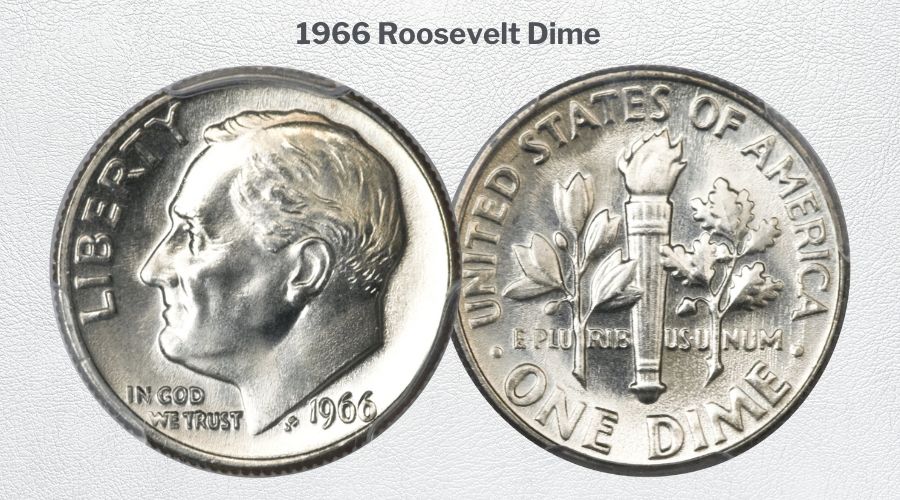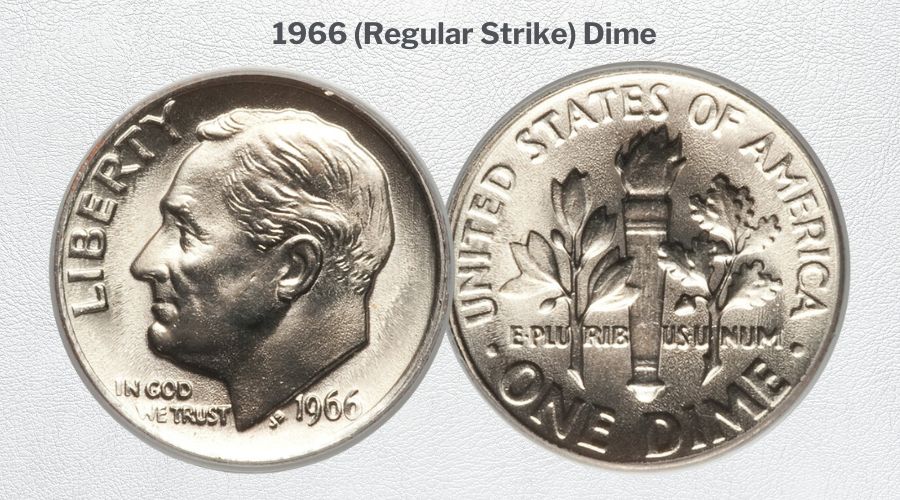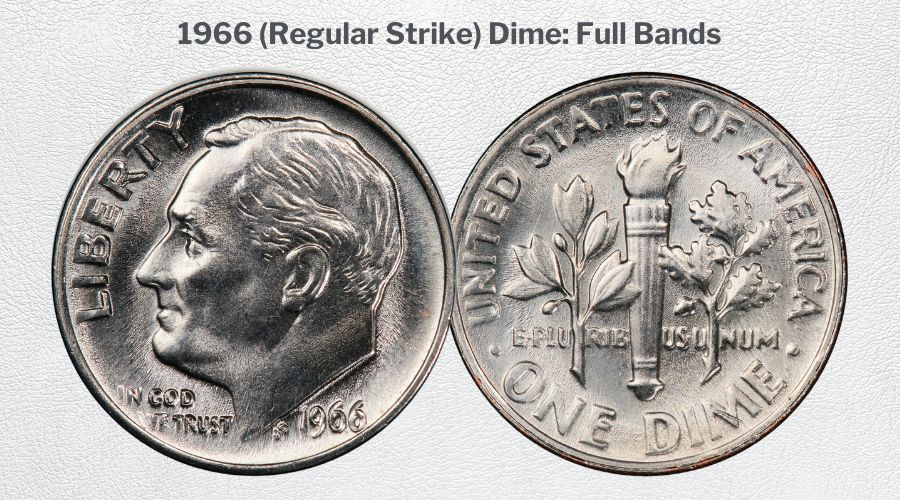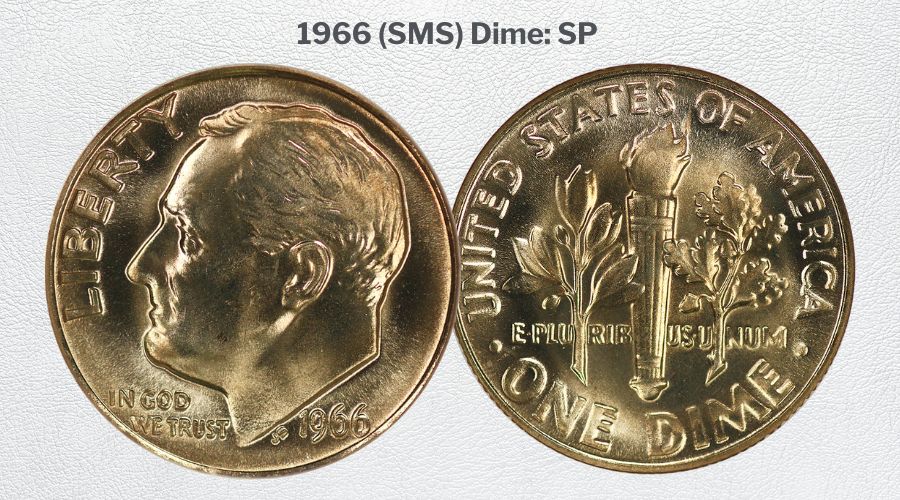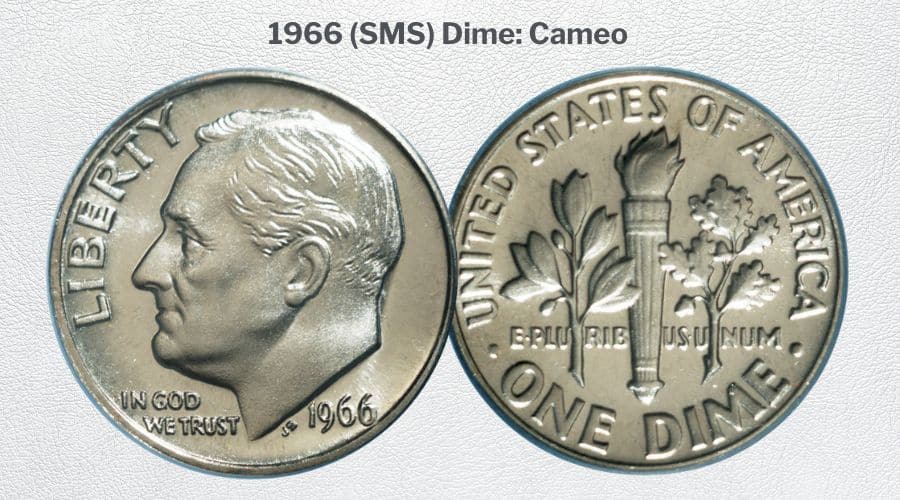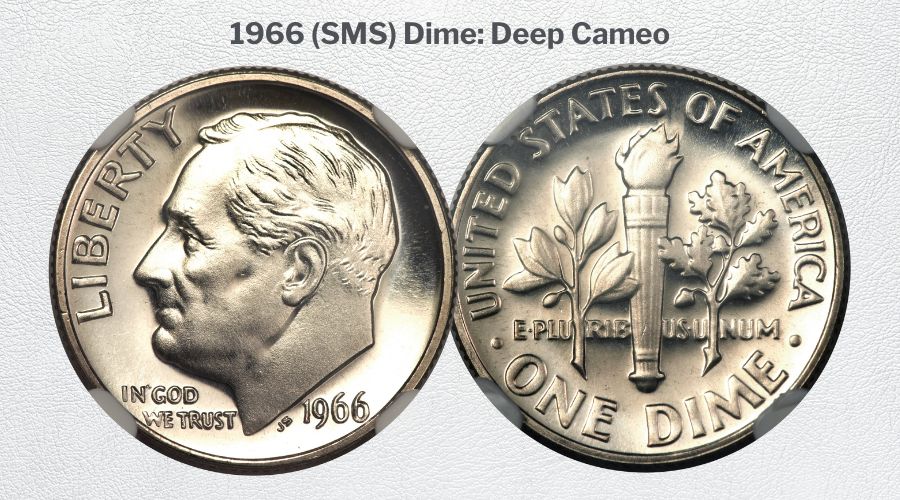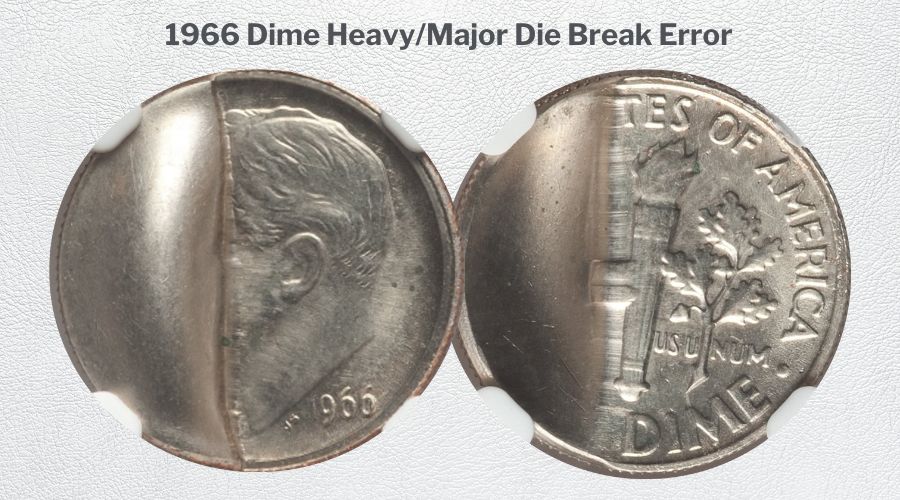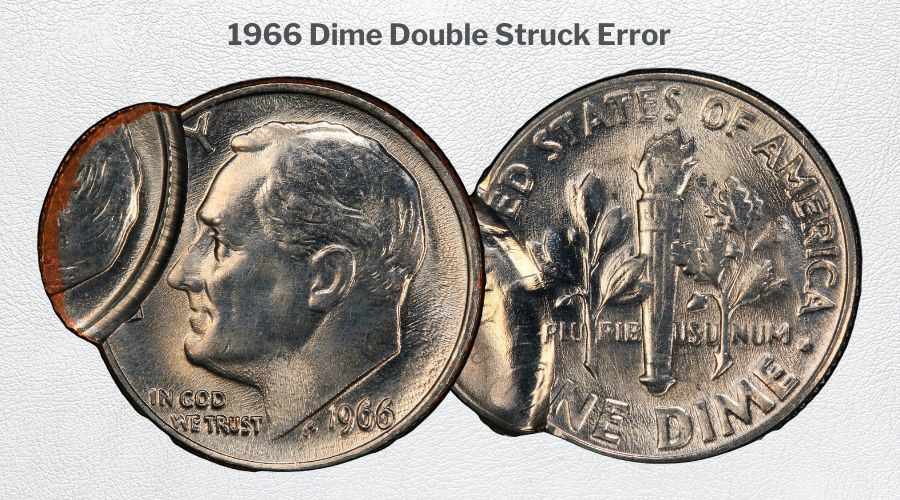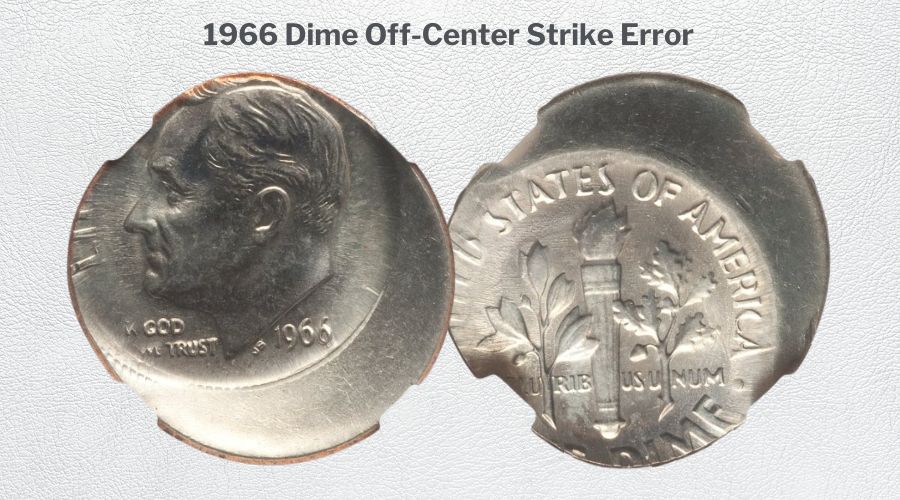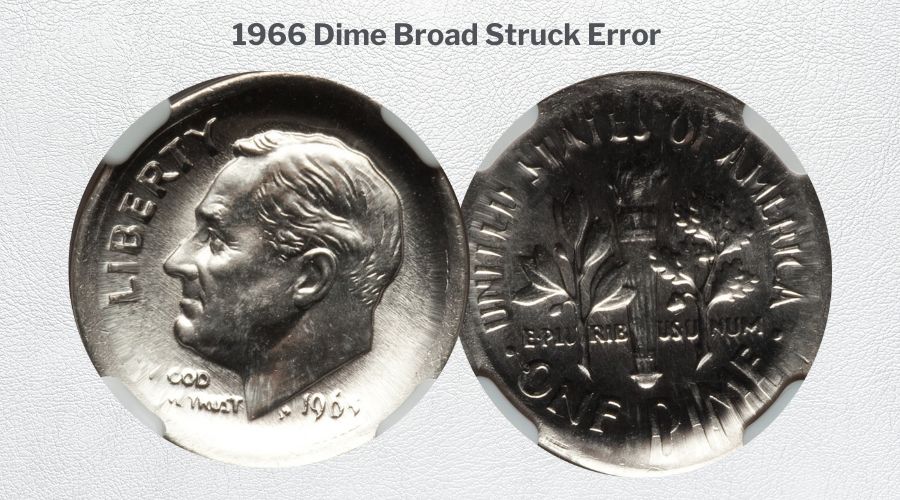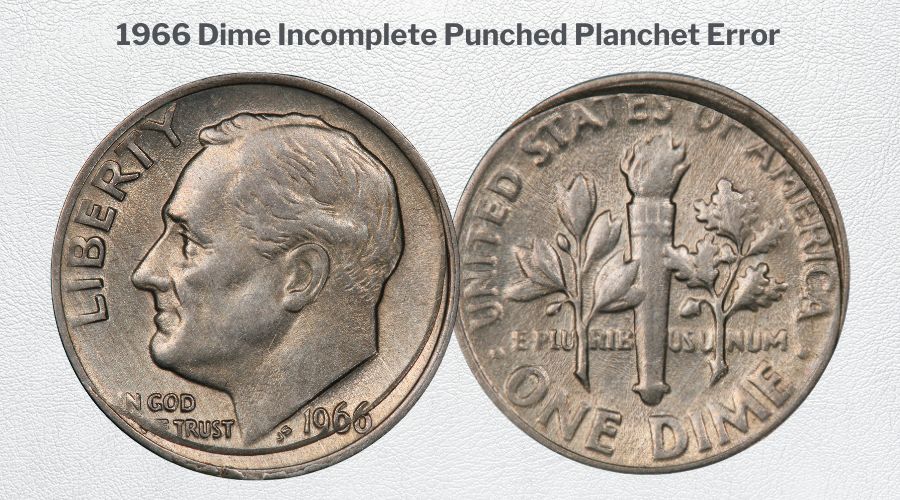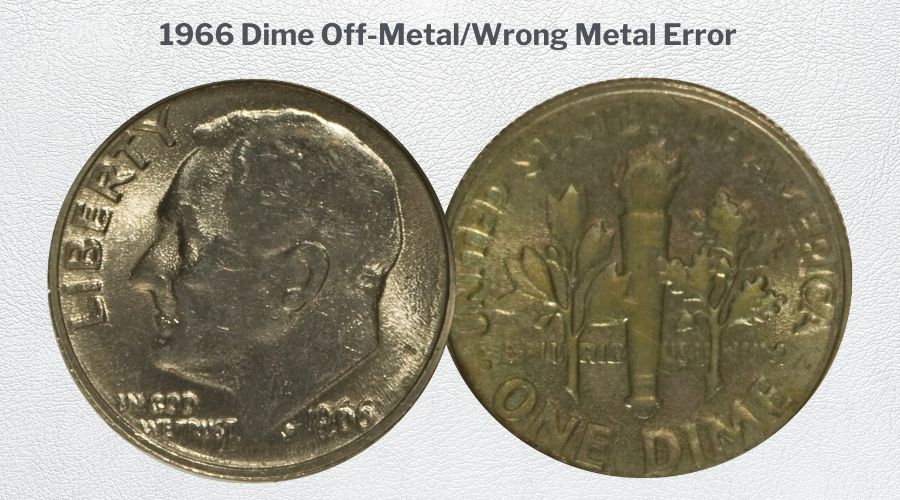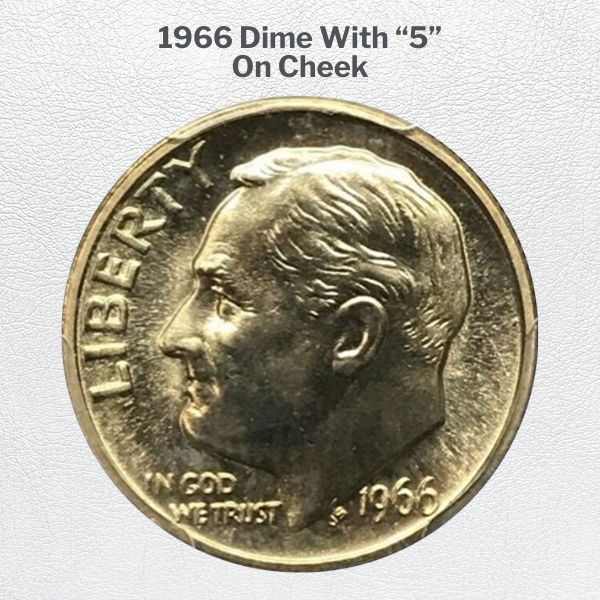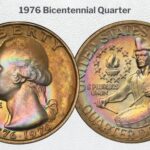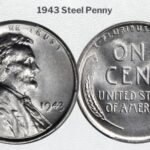Over 1 billion 1966 dimes were issued. This makes them extremely common coins that are easily found in circulation. Today, circulated versions are worth $0.15 while the uncirculated coins are worth $1 up to $725 in the highest grade.
Like other Roosevelt Dimes, the 1966 coins have a Full Bands variety that is more valuable than the regular one, worth $10 up to $2,900 in the highest grade. In fact, the highest price ever realized for the Full Bands variety was $2,820 in 2013.
However, if you are looking for the best coins to invest in, then your pick would be the 1966 SMS DCAM varieties. These dimes are the most valuable, worth up to $7,850 in the highest grade.
1966 Dime Details
- Category/Series: Roosevelt Dimes (1946 – Date)
- Mint: Philadelphia
- Mintage: 1,382,734,540
- Designer: John R. Sinnock
- Composition: 75% copper, 25% nickel over a pure copper center (copper-nickel clad)
- Weight: 2.27 grams
- Diameter: 17.90 millimeters
- Edge: Reeded
1966 dimes are part of the Roosevelt Dime series that began in 1946 after the death of Franklin Roosevelt in April 1945.
The Roosevelt Dime series replaced Mercury Dimes, and from 1946 to 1964, they were made of 90% silver and 10% copper.
1966 Dime Composition
By 1964, the Treasury was having a hard time producing such an expensive silver alloy coin and so decided to remove silver from the dime in favor of a much cheaper copper-nickel clad composition. The change proved effective and has since been the only metal composition in all dimes.
The first copper-nickel-clad dimes were made in 1965, making 1966 the second year the U.S. Mint issued dime coins without silver.
Since they lack silver, their melt value is lower (about $0.0206 compared to the $1.6378 in silver dimes). Many collectors have looked into these coins to find off-metal errors that may contain silver but none have been successful.
The silvery look of copper-nickel dimes can be confusing if you put them side by side with a silver dime. However, a good way to differentiate the two is by looking at the edges. Copper-nickel dimes have a brown-looking reeded edge that shows it has a copper core while silver dimes have a silver edge.
SMS Varieties
After 1964, the U.S. Mint did not issue any Proof Sets until 1968.
As a way to cut down on costs and increase the number of circulation coins, the Treasury ceased the production of Proof Sets in 1965 and focused its efforts on creating more than 1 billion circulation coins. This went on until 1968.
During that time, Special Strike coins, known as SMS (Special Mint Sets) were produced to fill the gap of Proofs. The SMS varieties weren’t of high quality as Proof Sets but they superseded the quality and strike of normal circulation coins.
1966 Dime Design and Minting
The obverse features Franklin Roosevelt, the 32th president of the United States facing to the left, LIBERTY, IN GOD WE TRUST, the date, and the designer’s JS initials.
The reverse shows a torch at the center flanked by an oak on the right and an olive branch on the left. ONE DIME is inscribed at the bottom center, UNITED STATES OF AMERICA at the top center, and E PLURIBUS UNUM across the lower center.
Note: 1966 Dimes are not only graded by their condition but also by the strike details of the torch sculpture on the reverse.
The torch has upper and lower horizontal bands. If a coin clearly separates these two bands, then it is labeled as a Full Bands (FB) variety, otherwise, the designation is left out.
Only coins above MS60 are given this designation since they do not have any cuts or marks across the bands that might be mistaken for separations.
As for mintage, only the Philadelphia Mint struck 1966 dimes:
| Mint | Mint Mark | Total Mintage |
| Philadelphia (Regular Strike) | No Mint mark | 1,382,734,540 |
| Philadelphia (SMS) | No Mint mark | 2,261,583 |
| Total Mintage | 1,384,996,123 |
What Makes the 1966 Dime Coin Valuable?
The main factors contributing to its value include:
1. Coin Condition
Collectors and numismatists value the SMS and uncirculated examples, especially those in the highest grades. These are coins with the sharpest strikes, attractive mint luster, and full details with little to no blemishes.
To know the condition of your coin, use the alphanumerical Sheldon Grading scale that ranks coins on a scale of 1 to 70, 70 being the highest.
For a more in-depth look, please read our simple complete guide on what coin grades mean.
2. Rarity
Only 2.2 million SMS coins were made compared to the 1.3 billion Regular Strikes. This makes the SMS versions much scarcer and in higher demand.
Also, Regular Strike coins are not rare in circulated conditions but they are scarce once you get to the highest grades.
As per NGC (Numismatic Grading Service) and PCGS (Professional Coin Grading Services), less than 900 examples exist above MS65.
At MS67 the coin is much harder to find and at MS68 it becomes a truly rare coin, with less than 50 known across the two major services.
3. Varieties – Full Bands and SMS
Full Bands (FB), also known as Full Torch (FT), are scarcer and more valuable in the collectors’ eyes. The same goes for SMS versions which feature the most attractive surfaces of all the coins.
Today, the 1966 SMS dimes are the most valuable.
4. Errors
The rarest errors more valuable than common 1966 dimes are:
- Major Die Break
- Double Struck
- Off Center
1966 Dime Varieties & Value
Below is the value chart, showing the market value of each 1966 dime:
| Coin | Circulated | AU50 – AU58 | MS60 – MS64 | MS65 + |
| 1966 (Regular Strike) Dime | $0.15 | $0.15 – $2 | $1 – $7 | $10 – $400 |
| 1966 (Regular Strike) Dime: Full Bands | N/A | N/A | $10 – $20 | $20 – $2,900 |
| 1966 (SMS) Dime: SP | N/A | N/A | $1 – $5 | $7 – $1,000 |
| 1966 (SMS) Dime: Cameo | N/A | N/A | $6 – $22 | $25 – $800 |
| 1966 (SMS) Dime: Deep Cameo | N/A | N/A | $40 – $300 | $415 – $7,850 |
1. 1966 (Regular Strike) Dime Value
According to NGC and PCGS price guides, the value of circulated 1966 dimes is $0.15. About Uncirculated is below $2 and uncirculated coins start from $1 and can rise up to $400 in the highest grade.
MS68 is the highest, with less than 15 known at this grade. This scarcity adds to its value since MS67, which is of pristine condition as well, is in plenty with more than 200 known.
Needless to say, this is the least profitable variety of the series.
The highest auction sale went for $705 in 2014 and that was for an MS68 coin with the finest details ever seen on any Regular Strike 1966 dime.
Below are the highest prices ever realized:
| Grade | Price | Firm | Sale Date |
| MS68 | $705 | Heritage Auctions | 2014 |
| MS68 | $440 | Great Collections | 2014 |
| MS68 | $152.75 | Heritage Auctions | 2014 |
| MS68 | $141 | Heritage Auctions | 2014 |
| MS68 | $80.30 | Great Collections | 2014 |
Lower-graded coins have sold for a lot of money as well. This is usually due to a rare mint error that adds to the coin’s appearance and uniqueness. An example is this MS66-graded “Major Die Break” coin that sold for $660 in 2020.
However, error coins are valued differently and therefore categorized differently.
2. 1966 (Regular Strike) Dime: Full Bands Value
Full Bands variety is worth $10 – $2,900.
MS68 is the highest known grade, valued between $700 and $2,900.
The highest historical value was for $2,820 in 2013 – this was an MS68 FB coin, known at the time as the sole finest Full Bands issue. Its surface is filled with strong luster and only a minor die erosion appears on the portrait. Otherwise, it’s spotless.
Below are the highest prices ever realized:
| Grade | Price | Firm | Sale Date |
| MS68 FB | $2,820 | Heritage Auctions | 2013 |
| MS67 FB | $822.50 | Heritage Auctions | 2016 |
| MS68 FB | $619.20 | Heritage Auctions | 2020 |
| MS68 FB | $558.13 | Heritage Auctions | 2014 |
| MS67 FB | $352 | Great Collections | 2014 |
3. 1966 (SMS) Dime: SP
SMS dimes are graded using the SP or MS designation depending on the grading service. Regardless, they all refer to coins with very sharp strikes that display extremely clear details on the obverse and reverse.
The coins have smooth satin-like appearances with zero contact marks that show they were struck under extreme care and handle.
SP-designated SMS coins are the least valuable of the SMS issues. Deep Cameo is the most profitable followed by Cameo.
SPs are worth $1 – $1,000. The highest sale went for $999 in 2013 – it was an SP69/MS69, the sole finest at the time.
Below are the highest prices ever realized:
| Grade | Price | Firm | Sale Date |
| MS69 | $999 | Heritage Auctions | 2013 |
| SP68 | $235 | David Lawrence | 2023 |
| MS69 | $214.50 | Great Collections | 2012 |
| SP69 | $200 | David Lawrence | 2019 |
| MS69 | $186 | Heritage Auctions | 2020 |
4. 1966 (SMS) Dime: Cameo Value
Cameo dimes are designated by SP/MS followed by Cameo. They feature a frosty appearance and reflective fields that are more detailed than their SP versions.
The coins go for $6 in their lowest grade but can be worth more than $700 in the highest.
The highest sale went for $1,035 in 2004 – featuring a seemingly flawless MS68 Cameo with frosted devices and extreme reflective fields.
Below are the highest prices ever realized:
| Grade | Price | Firm | Sale Date |
| MS68 Cameo | $1,035 | Heritage Auctions | 2004 |
| MS68 Cameo | $1,020 | Heritage Auctions | 2003 |
| MS69 Cameo | $805 | Heritage Auctions | 2005 |
| MS68 Cameo | $805 | Heritage Auctions | 2003 |
| MS69 Cameo | $775 | Heritage Auctions | 2018 |
5. 1966 (SMS) Dime: Deep Cameo Value
Deep Cameo dimes are designated by SP/MS followed by Deep Cameo (DCAM) or Ultra Cameo.
They feature a Cameo finish with a deep contrast between the frosted appearance and reflective fields. With such pristine surfaces, they stand out as the most attractive and detailed 1966 dimes.
They are worth $40 in their lowest grade but can be worth more than $7,000 in the highest. The highest sale went for $2,760 in 2007 – featuring an SP68 DCAM with deeply frosted surfaces and light golden toning.
Below are the highest prices ever realized:
| Grade | Price | Firm | Sale Date |
| SP68 DCAM | $2,760 | Heritage Auctions | 2007 |
| SP68 DCAM | $1,955 | Heritage Auctions | 2012 |
| SP68 DCAM | $1,955 | Heritage Auctions | 2003 |
| SP67 DCAM | $403 | Heritage Auctions | 2006 |
| SP67 DCAM | $373.75 | Heritage Auctions | 2008 |
1966 Dime Errors
Below are the most valuable errors ever found among 1966 dimes:
1. Heavy/Major Die Break
A major die break, also known as CUD, is when a die used to create the coin has a huge crack/break. Therefore, when the coin is struck with the defective die, a raised metal lump ends up forming on the coin.
In this major obverse die break, you will see a coin that was struck using a defective obverse die. The die break caused a huge lump to form on the entire left-half side of the obverse. It sold for $660 in 2020 and $384 in 2021.
A look at auction sites like Heritage shows that coins with this error above AU55 sell for more than $25.
2. Double Struck
A double strike error happens when a coin is struck normally and then two more times, but slightly off-center. As a result, the coin develops double lettering, numbers, or design elements.
An example is this MS63 coin that sold for $360 in 2022. It was stuck 80% off-center leaving most of the details.
This type of error is worth more if 40-80% of the features are missing on both sides of the coin.
3. Off-Center Strike Error
Off-center errors happen when a planchet is improperly positioned. This leads to a coin with missing design elements. Similar to the Double Strike above, the most desirable examples have 40-80% missing features on both sides.
The highest sale with this error was an MS65 coin that sold for $186 in 2020. In this case, the strike was 25% off-center.
The coin’s grade also contributes to its value. For example an MS63 with a 50% off center strike sold for $104 in 2020.
Generally speaking, the value of these coins in Mint State is $20 – $190.
4. Broad Struck
Broad strikes happen when the retaining collar used in production goes missing when striking a coin. This causes the coin to have an irregular elliptical or round shape, usually larger than the original design.
Only one 1966 dime has been sold with this error – MS65 sold for $42 in 2011. The design elements on the coin are warped inward as if being sucked into the center leaving the outer rim empty.
5. Incomplete Punched Planchet
These are coins made from planchets that had missing portions before striking began. The coin ends up with an irregular shape, missing portion, or cramped design details.
This AU58 sold for $139 in 2022. It features a coin that was struck on a planchet that wasn’t fully shaped and had creases and missing strips. Another MS63 sold for $31 in 2021 but in this case, a semicircular portion on the left-hand side was completely missing. It looks like a small bite bitten off the coin.
6. Off-Metal/Wrong Metal Error
Off-metal errors, also known as wrong planchet or wrong metal, happen when an irregularly shaped coin is formed after striking it on a planchet (blank) meant for a different coin.
These errors are worth $30 or more in Uncirculated grades.
An example is the MS64 sold for $56 in 2009. It is a regular 1966 dime that was struck on a thicker planchet than the one it was supposed to. Instead of 2.27 grams, this coin is 3 grams.
A similar example in AU58 sold for $30 in 2014.
Frequently Asked Questions
What Is The 1966 Dime With “5″ On Cheek?
The highest sale record on eBay for the 1966 dime was towards a coin with the number “5” on the cheek. This SP67 Superb Gem Specimen sold for $12,499.99.
Several listings have come up over the years talking about the error.
However, it is important to note that no numismatic grading company has legitimized this error. It seems speculative at the moment and is not worth investing in.
Also Read: Rare Dimes that Worth Money
Conclusion
The only 1966 dimes you should invest in are those in the highest uncirculated grades, MS68 or higher. These coins are worth a few hundred dollars up to a couple thousand. If you happen to get a Full Bands variety the better.
The 1966 SMS DCAM is the most valuable, fetching over $400 per coin in MS65 or higher. You may also opt for error coins but very few are worth more than $200, specifically Major Die Break and Double Struck errors.
All in all, for the soundest investment plan, stay clear of circulated 1966 dimes since they won’t be worth more than $0.15.

